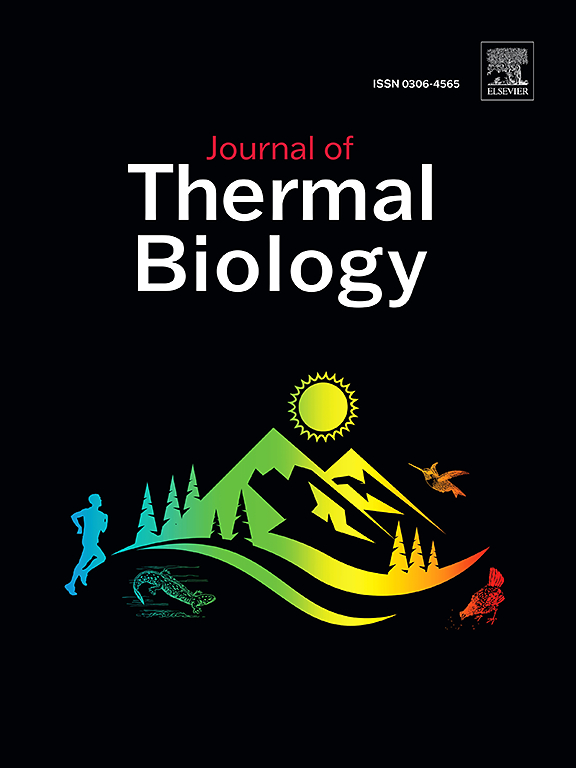Role of the nasal cavity as a perception site of environmental humidity via a menthol-sensitive cold reception mechanism
IF 2.9
2区 生物学
Q2 BIOLOGY
引用次数: 0
Abstract
Humans can sense environmental humidity; however, the mechanism underlying this ability remains unclear. This study aimed to clarify whether the nasal cavity is involved in humidity sensation. Experiments were conducted on healthy young adults, in which controlled nasal inhalation was conducted under four air conditions (i.e., temperature of 25 °C or 34 °C with relative humidity [RH] of 30 % and 70 %). The temperature of the nasal mucosa and the thermal and humidity sensations of the inhaled air were assessed in the first experiment. In the second and third experiments, sublimated l-menthol was added to the inhaled air, and the sensations of the inhaled air were evaluated. The temperature of the nasal mucosa was higher in inhaled air at 34 °C with 30 % RH than at 25 °C. The rating for thermal sensation (warm sensation) was the highest at 34 °C and 70 % RH. At both temperatures, the humidity sensation rating was higher in air with 70 % RH than in air with 30 % RH. Linear relationships were observed between the ratings for thermal and humidity sensations under the four conditions (R2 = 0.339–0.516). The thermal sensation rating decreased when air at 34 °C was inhaled with l-menthol. A linear relationship was also observed between the ratings for thermal and humidity sensations under this condition (R2 = 0.665). These findings suggest that the nasal cavity is critical for the sensation of humidity in an environment in which cold reception via the TRPM8 channel is involved.
鼻腔通过薄荷醇敏感冷接受机制作为环境湿度感知部位的作用
人类可以感知环境湿度;然而,这种能力背后的机制尚不清楚。本研究旨在阐明鼻腔是否参与湿度感觉。实验对象为健康青年,在四种空气条件下(即温度为25°C或34°C,相对湿度[RH]为30%和70%)进行鼻腔吸入控制。在第一个实验中,评估了鼻黏膜的温度和吸入空气的热湿感觉。在第二和第三个实验中,将升华的l-薄荷醇加入吸入空气中,并评估吸入空气的感觉。在34℃、30% RH条件下吸入的空气中,鼻黏膜温度高于25℃条件下。热感觉等级(热感觉)在34°C和70% RH时最高。在两种温度下,70% RH的空气的湿度感觉等级高于30% RH的空气。四种条件下的热湿感觉评分呈线性关系(R2 = 0.339 ~ 0.516)。用l-薄荷醇吸入34℃空气时,热感觉等级下降。在这种情况下,热感觉和湿感觉的等级之间也存在线性关系(R2 = 0.665)。这些发现表明,在通过TRPM8通道接受寒冷的环境中,鼻腔对湿度的感觉至关重要。
本文章由计算机程序翻译,如有差异,请以英文原文为准。
求助全文
约1分钟内获得全文
求助全文
来源期刊

Journal of thermal biology
生物-动物学
CiteScore
5.30
自引率
7.40%
发文量
196
审稿时长
14.5 weeks
期刊介绍:
The Journal of Thermal Biology publishes articles that advance our knowledge on the ways and mechanisms through which temperature affects man and animals. This includes studies of their responses to these effects and on the ecological consequences. Directly relevant to this theme are:
• The mechanisms of thermal limitation, heat and cold injury, and the resistance of organisms to extremes of temperature
• The mechanisms involved in acclimation, acclimatization and evolutionary adaptation to temperature
• Mechanisms underlying the patterns of hibernation, torpor, dormancy, aestivation and diapause
• Effects of temperature on reproduction and development, growth, ageing and life-span
• Studies on modelling heat transfer between organisms and their environment
• The contributions of temperature to effects of climate change on animal species and man
• Studies of conservation biology and physiology related to temperature
• Behavioural and physiological regulation of body temperature including its pathophysiology and fever
• Medical applications of hypo- and hyperthermia
Article types:
• Original articles
• Review articles
 求助内容:
求助内容: 应助结果提醒方式:
应助结果提醒方式:


